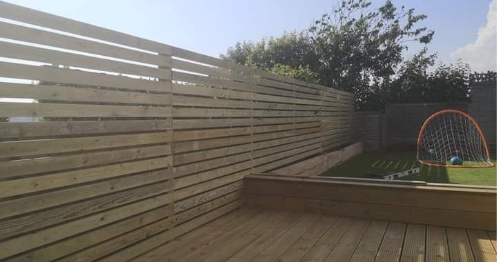
Finding the right type of fence for your garden project is more challenging than it sounds. So before you settle on any old panel, we suggest you properly plan and consider what purpose your fence will serve. Here are a few pointers to help you arrive at the right decision.
As primitive as this question might sound, deciding on what your fence needs to achieve is a great starting point for finding the right panel.
For most homeowners, privacy and security have the strongest influence when deciding on a style. But it’s also worth considering those secondary requirements you might otherwise ignore.
For example, you might need a panel to securely enclose your pets, or you might live in a high-wind area where additional reinforcement is needed. Or perhaps, like our recent client, you live by the coast and want to keep your sea view from the garden.
Whatever your needs, it’s worth investing a little more time in deciding on the right panel to meet your requirements. And if you’re unsure what you need, feel free to give us a call.
If you want to maximise security and privacy, we suggest opting for a solid fence panel such as tongue and groove. With no gaps within the pales, they offer more strength and noise reduction when compared to semi-solid counterparts. They’re also difficult to climb, which is great for both child safety and security.
Should you wish to compromise a little security for added style, you could consider semi-solid panels such as Woven, Venetian or Palisade. Both of which offering a classic finish suitable for where privacy isn’t a main priority.
For added protection and longevity, it’s also important you pressure treat your fence panels (as per manufacturer instruction) to ensure they maintain their strength – especially through the colder months.
If you live in a wind-prone area (which is probably the case if you reside near the coast), you’ll need to go further than standard installation methods to secure your solid-panel fence, by:
Of course, in wind-prone areas, we’d recommend a semi-solid panel to omit some of the pressure on your panels. But if security and privacy are priority, a correctly installed solid panel might be a better option.
Off-the-shelf fence panels are typically available in the following sizes:
If you require a custom-sized panel, some fencing suppliers may be able to accommodate or, if you haven’t got time to source bespoke sizes, speak to a local landscaper.
Picket fencing is a great option for pet friendly gardens. Otherwise known as palisade fencing, it’s a traditional style finish that offers strength and quality with a finished height of up to 1.8m. Available with rounded or pointed tops, it’s a sturdy and affordable option that keeps your four-legged friends safe.